The healthy posture and positive change that antique images can bring to modern people are potentially transformational. In Part 1 of this series we looked at how learning from old photographs can benefit our upper body posture and in Part 2 the lower body.
Here we are going to focus on what antique portraits can teach us about small bends. The historical paintings for this post come from collections associated with Leland and Jane Stanford, famous for their business acumen, political influence, railroad building, and later, philanthropy as founders of Stanford University in California.
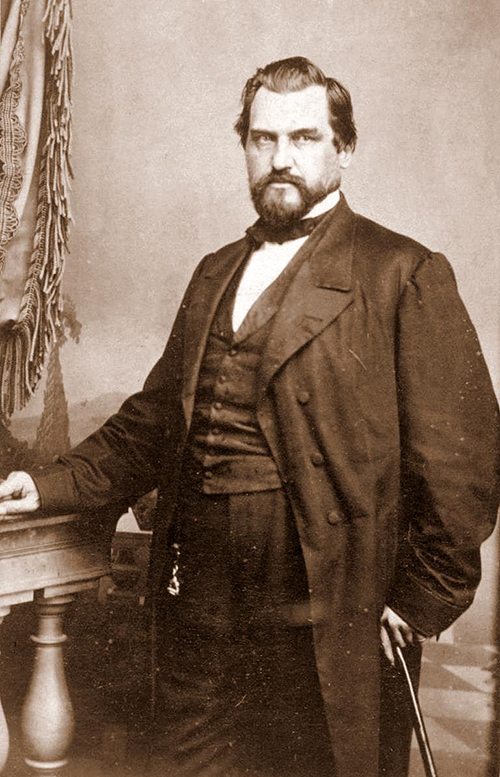
Leland Stanford c. 1870. His open chest and posterior shoulder position are typical of the fine posture of his day. Wikipedia
How much do small bends really matter? After all, it is the deeper bends, perhaps with lifting involved, that pose a bigger threat to our spine. Here are three reasons to pay attention to small bends:
- The start of a bend usually sets its trajectory. If you have a problematic start to your bend, it will likely continue that way.
- Small bends are done more often. Any systematic error in your form can therefore create a significant amount of cumulative damage. They also present more opportunities for training in healthy posture habits.
- Some people’s backs “go out” even with small bends.
Living on the Stanford campus for decades, I was a frequent visitor and admirer of many of the artefacts in the Cantor Arts Center (formally Stanford University Museum). Many of its artefacts represent the human story from foreign lands and ancient periods of history. But within the museum there is also a collection documenting the lives of the Stanford family, which represents a homegrown heritage that teaches us much of what we need to know about healthy posture.
Let’s start with a painting of the Stanford family at leisure, celebrating the 10th birthday of Leland Stanford Jr. . .
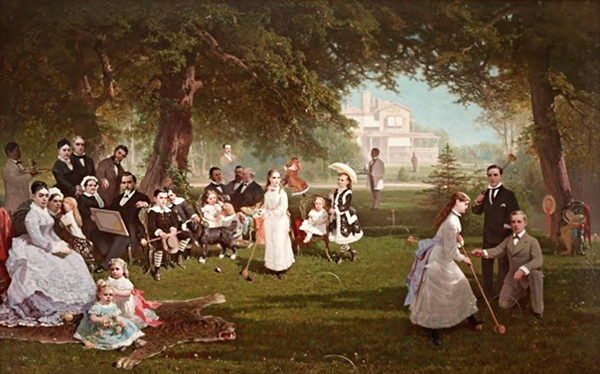
“Palo Alto Spring” by Thomas Hill, 1879, Cantor Arts Center, Stanford University. Kiddle

A girl playing croquet bends forward slightly (detail, right foreground). Kiddle
The girl playing croquet is an example of a small bend done pretty well. Notice how she angles forward almost exclusively at her hips, rather than at her waist, and also maintains an elegantly elongated spine. By angling forward at the hip joint, where the pelvis pivots around the top of the thigh bones, her hip joints get to enjoy the rotational movement they are designed for. Her spine follows her pelvis, with her back muscles and inner corset both gently working to keep her entire torso as one piece.
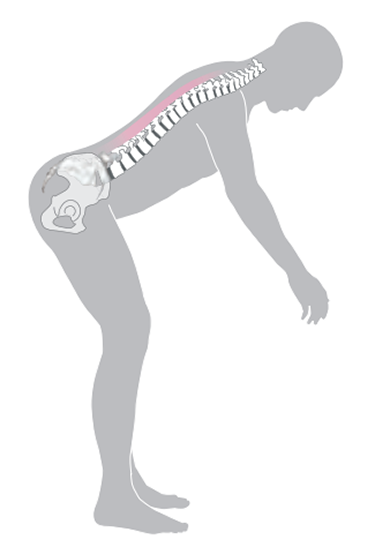
When the pelvis and torso remain aligned, bending brings beneficial work for the hips,
deep abdominal muscles, and back muscles (fig a.).
This is a much healthier way to bend (fig a.) than fixing the pelvis in a tucked position and then rounding the spine to bend forward (fig b.). Rounding loads the discs, compressing them anteriorly and causing them to bulge posteriorly. With frequent repetition the microaggressions of even small bends take their toll on the discs. Rounding also overstretches the spinal ligaments, allowing for increasingly hunched posture. Even a small bend done in this way may be perceived by the brain as a threat and send the muscles into spasm, trying to prevent movement and protect against such misuse and damage.
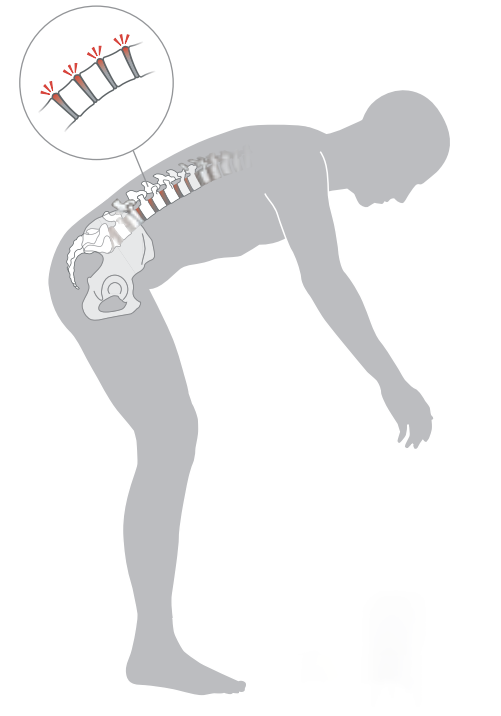
Rounding the back to bend squeezes the disc contents back, where they may bulge and impinge on the nerve roots (fig b.).
In the painting “The Last Spike” by Thomas Hill (below), you can see a small bend employed in a kneeling position. The two figures kneeling on either side of Stanford could be tucked and rounded, but instead, they are hinging at the hip joint and keeping their backs straight. The woman to their right, leaning on her parasol, also angles forward in a mild hip-hinge.
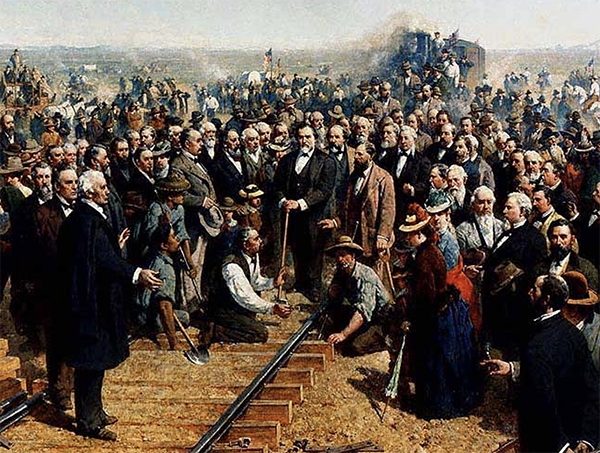
A late 19th century painting shows Stanford, one of the owners of the Central Pacific Railroad, standing ready to hammer the golden and ceremonial “Last Spike” into the ground at Promontory Summit, Utah, in May 1869. Wikimedia
Small bends can be as subtle as a nod or tiny inclination forward. In the foreground of a different painting below, also entitled “The Last Spike,” the onlooker on the left rounds his upper back as he looks downward. I suspect that his desire or need to show deference, also suggested by his removal of his cap, has overridden the prevailing bending posture of the day. Societal expectations around status and hierarchy are responsible for substantial postural degradation throughout history. More about that in a future blog post.

An alternative composition of “The Last Spike,” showing a less healthy type of small bend. historyisnowmagazine.com
This small degree of rounding is what many people do numerous times in a day to pick things up—perhaps to grab our car keys from a table or move things from the counter to the sink. Any forward movement with the upper back and head will often result in counter-tension in the lower back and/or pelvis to hold you there. Rather than compromise our backs, it is far healthier to keep our necks tall and bend at the hip joint.
If you would like to practise this important contribution to your back health, join me for a “small bends” Gokhale Exercise class on Friday, November 12 at 9:45 a.m. (Pacific Time). If you have not yet subscribed to the 1-2-3 Move program, sign up now for your 7-day Gokhale Exercise Free Trial.

1-2-3 Move happens daily with Esther or guest teachers at 9:45 a.m.
Gokhale Fitness with Eric runs Mondays, Wednesdays, Fridays from 7–7:25 a.m.
(Pacific Time), and Tuesdays, Thursdays, Saturdays from 3–3:25 p.m. (Pacific Time)
Gokhale Moving Meditation with Roberta is Mondays at 2 p.m. and with Kathleen is Wednesdays at 12 p.m. (Pacific Time)



Comments
It's intriguing to explore
It's intriguing to explore the historical context of healthy posture through the lens of the Stanford family's collection at the Cantor Arts Center. The idea that a museum not only houses artifacts from foreign lands and ancient history but also preserves the domestic heritage of a prominent family is fascinating.
The mention of a painting capturing the Stanford family at leisure during the celebration of Leland Stanford Jr.'s 10th birthday opens a window into a specific moment in time. Paintings often serve as visual records, offering insights into the https://22bet-casino.cz/ daily lives, social customs, and postural habits of the subjects.
I'm curious to know more about the details captured in the painting. Are there distinctive elements in the posture of the Stanford family members that stand out? How does this representation of leisure and celebration reflect on the understanding of healthy posture within a familial and social context?
Additionally, if there are other artifacts or aspects of the Stanford family's collection that shed light on their approach to health and posture, it would be fascinating to delve into those details.
With keen perception, I
With keen perception, I seized the opportunity to invest my in-game currency in acquiring these priceless treasures. Through strategic maneuvers and calculated acquisitions, I accumulated a wealth of virtual riches, transforming my gaming excursion into a profitable endeavor. As tales of my exploits spread far and wide, players from every corner of the gaming realm converged to partake in the резка хд pursuit of digital fortune, fueling demand and driving profits to unprecedented heights. What began as a routine gaming session had blossomed into a masterclass in digital entrepreneurship, proving that with ingenuity and perseverance, even the most concealed treasures could be unearthed.
Today's exploration of the
Today's exploration of the digital frontier within the gaming universe revealed an unexpected odyssey—a journey of discovery and opportunity. As I traversed the virtual terrain, I stumbled upon a hidden sanctuary—a bustling marketplace teeming with potential opções binárias corretoras and ripe for exploration. Captivated by the promise of hidden riches, I embarked on a quest to unveil the mysteries concealed within the marketplace's depths. With each stride, I encountered new marvels—a trove of rare artifacts, a collection of precious relics, each more coveted than the last.